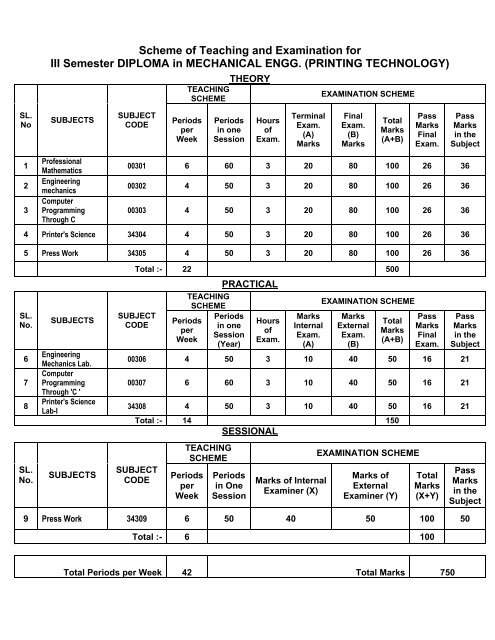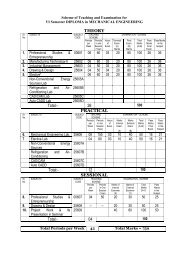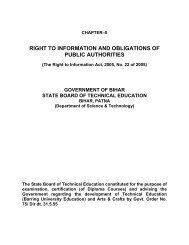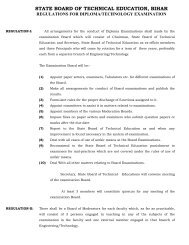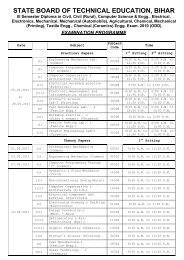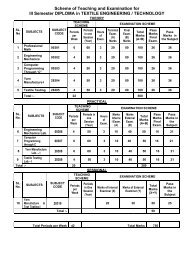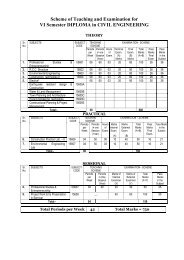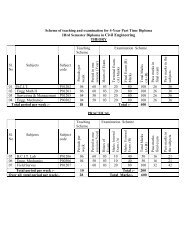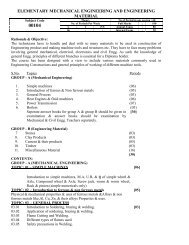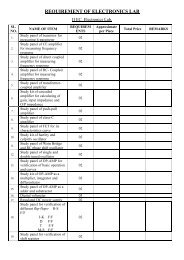Scheme of Teaching and Examination for III ... - SBTE Home Page
Scheme of Teaching and Examination for III ... - SBTE Home Page
Scheme of Teaching and Examination for III ... - SBTE Home Page
Create successful ePaper yourself
Turn your PDF publications into a flip-book with our unique Google optimized e-Paper software.
<strong>Scheme</strong> <strong>of</strong> <strong>Teaching</strong> <strong>and</strong> <strong>Examination</strong> <strong>for</strong><br />
<strong>III</strong> Semester DIPLOMA in MECHANICAL ENGG. (PRINTING TECHNOLOGY)<br />
THEORY<br />
TEACHING<br />
SCHEME<br />
EXAMINATION SCHEME<br />
SL.<br />
No<br />
SUBJECTS<br />
SUBJECT<br />
CODE<br />
Periods<br />
per<br />
Week<br />
Periods<br />
in one<br />
Session<br />
Hours<br />
<strong>of</strong><br />
Exam.<br />
Terminal<br />
Exam.<br />
(A)<br />
Marks<br />
Final<br />
Exam.<br />
(B)<br />
Marks<br />
Total<br />
Marks<br />
(A+B)<br />
Pass<br />
Marks<br />
Final<br />
Exam.<br />
Pass<br />
Marks<br />
in the<br />
Subject<br />
1<br />
2<br />
3<br />
Pr<strong>of</strong>essional<br />
Mathematics<br />
Engineering<br />
mechanics<br />
Computer<br />
Programming<br />
Through C<br />
00301 6 60 3 20 80 100 26 36<br />
00302 4 50 3 20 80 100 26 36<br />
00303 4 50 3 20 80 100 26 36<br />
4 Printer's Science 34304 4 50 3 20 80 100 26 36<br />
5 Press Work 34305 4 50 3 20 80 100 26 36<br />
SL.<br />
No.<br />
6<br />
7<br />
8<br />
SL.<br />
No.<br />
SUBJECTS<br />
Engineering<br />
Mechanics Lab.<br />
Computer<br />
Programming<br />
Through 'C '<br />
Printer's Science<br />
Lab-I<br />
SUBJECTS<br />
Total :- 22 500<br />
PRACTICAL<br />
TEACHING<br />
EXAMINATION SCHEME<br />
SCHEME<br />
Periods<br />
Marks Marks<br />
Periods<br />
Hours<br />
Total<br />
in one<br />
Internal External<br />
per<br />
<strong>of</strong><br />
Marks<br />
Session<br />
Exam. Exam.<br />
Week<br />
Exam.<br />
(A+B)<br />
(Year)<br />
(A) (B)<br />
SUBJECT<br />
CODE<br />
Pass<br />
Marks<br />
Final<br />
Exam.<br />
Pass<br />
Marks<br />
in the<br />
Subject<br />
00306 4 50 3 10 40 50 16 21<br />
00307 6 60 3 10 40 50 16 21<br />
34308 4 50 3 10 40 50 16 21<br />
Total :- 14 150<br />
SESSIONAL<br />
SUBJECT<br />
CODE<br />
TEACHING<br />
SCHEME<br />
Periods<br />
per<br />
Week<br />
Periods<br />
in One<br />
Session<br />
Marks <strong>of</strong> Internal<br />
Examiner (X)<br />
EXAMINATION SCHEME<br />
Marks <strong>of</strong><br />
External<br />
Examiner (Y)<br />
Total<br />
Marks<br />
(X+Y)<br />
Pass<br />
Marks<br />
in the<br />
Subject<br />
9 Press Work 34309 6 50 40 50 100 50<br />
Total :- 6 100<br />
Total Periods per Week 42 Total Marks 750
Subject Code<br />
00301<br />
PROFESSIONAL MATHEMATICS<br />
Theory No <strong>of</strong> Period in one session : 60<br />
No. <strong>of</strong> Periods Per Week Full Marks : 100<br />
L T P/S Annual Exam. : 80<br />
06 00 00 Internal Exam. : 20<br />
Rationale:<br />
A technical diploma holder is engaged generally as first line supervisor. He <strong>for</strong>ms a bridge between workers <strong>and</strong><br />
management. He has to underst<strong>and</strong> the language <strong>of</strong> the modern management <strong>and</strong> communicate with the workers in their<br />
language. This subject will help accomplishment <strong>of</strong> the task in stipulated time, develop attitude towards cost effectiveness,<br />
selection <strong>of</strong> most effective alternative methods. This course will also help the student to tackle different numerical methods<br />
<strong>and</strong> computational techniques <strong>for</strong> problem solving in research organization as a programmer.<br />
Objective:<br />
The course enables students to.<br />
• Managerial skill based on mathematical footing<br />
• The ability to find approximate solutions <strong>and</strong>/or answers to the problems where analytical methods become more<br />
complex.<br />
• To choose correct numerical techniques <strong>for</strong> a given problem.<br />
S.No. Topics Periods<br />
01 GROUP –A (Numerical Methods) (20)<br />
02 GROUP-B (Statistical Techniques) (20)<br />
03 GROUP-C (Management Techniques) (20)<br />
Total: (60)<br />
CONTENTS:<br />
GROUP-A (NUMERICAL METHODS) (20)<br />
01.01 Introduction to Numerical methods: Approximation <strong>and</strong> errors (Truncation & Round <strong>of</strong>f).<br />
01.02 Numerical solutions <strong>of</strong> non-linear <strong>and</strong> Transcendental equations: Iterative methods. Newton-Raphson’s<br />
method. Bisection method <strong>and</strong> Regula-Falsi method.<br />
01.03 Solution <strong>of</strong> Linear Simultaneous Equations: Gaussian Elimination method <strong>and</strong> Gauss-Jordan method.<br />
01.04 Finite Difference: Backward <strong>and</strong> <strong>for</strong>ward Differences. Finite Difference Interpolation Formula. Newton’s<br />
Forward Difference <strong>for</strong>mula <strong>and</strong> Newton’s Backward Difference <strong>for</strong>mula.<br />
01.05 Numerical Differentiation & Integration: Newton’s <strong>for</strong>ward <strong>and</strong> backward differentiation <strong>for</strong>mula.<br />
Trapezoidal Rule <strong>and</strong> Simpson’s 1/3 rule <strong>for</strong> numerical integration.<br />
01.06 Difference equations. simple problem Only<br />
GROUP-B (STATISTICAL TECHNIQUES) [20]<br />
02.01 Introduction to statistics: Measure <strong>of</strong> central tendencies: measures <strong>of</strong> dispersions: st<strong>and</strong>ard deviation <strong>and</strong><br />
variance <strong>for</strong> discrete <strong>and</strong> grouped data: assumed mean <strong>and</strong> step deviation methods.<br />
02.02 Theory <strong>of</strong> Probability: R<strong>and</strong>om events <strong>and</strong> their types. Probability <strong>of</strong> Events. Definitions. Laws <strong>of</strong><br />
Probability (Addition <strong>and</strong> Multiplication Laws)<br />
02.03 Probability Distribution: Introduction to Arithmetic Mean <strong>and</strong> St<strong>and</strong>ard Deviation <strong>of</strong> a probability<br />
distribution. Important probability distribution – Binomial distribution. Poisson’s distribution & Their means<br />
<strong>and</strong> variance.<br />
GROUP-C (MANAGEMENT TECHNIQUES) [20]<br />
03.01 Linear Models<br />
03.01.01 Introduction to Operations Research (O.R) Steps <strong>of</strong> O.R.<br />
03.01.02 Linear Programming Problems: Formulation <strong>of</strong> a LPP. Mathematical Modelling <strong>and</strong> Solution by graphical<br />
method.<br />
03.01.03 Solution by Simplex Method: Basic Feasible Solution (Degenerator <strong>and</strong> Non-degenerator)<br />
03.01.04 Transportation problem: Introduction <strong>and</strong> Solution Procedure-<br />
(i) Finding the initial basic feasible solution by N-W Corner Rule, Least cost method <strong>and</strong> Vogel’s<br />
Approximation Method.<br />
(ii) Test <strong>of</strong> optimality by u-v method only.<br />
03.01.05 Assignment Problem: Introduction <strong>and</strong> Solution Procedure–Fundamental theory underlying Hungarian<br />
Method.<br />
03.02 Network Analysis. CPM & PERT: Introduction.<br />
2
03.02.01 Basic concepts – Activities. Nodes. Edges. Networking <strong>of</strong> a project. Various times calculations. CPM to<br />
determine the optimal project schedule.<br />
03.02.02 PERT- Definition, difference between CPM & PERT. Pessimistic times, optimistic times. Most likely times<br />
<strong>of</strong> various activities.<br />
Books Recommended: Text Books<br />
1. Operations Research. Sultan Ch<strong>and</strong> & Sons, New Delhi, 1990 - Kanti Swaroop. P.K Gupta <strong>and</strong> Man Mohan<br />
2. Operations Research. Sultan Ch<strong>and</strong> & Sons, New Delhi, 1990 - Heera & Gupta<br />
3. Operations Research. Macmillan Publishing Co. New York, 1982 - H.A.Taha<br />
4. Computer based numerical algorithm, East West Press, 1975 - E.V Krishna Murthy & S.V. Sen<br />
5. Computer oriented numerical method, Prentice Hall India, 1980 - V. Rajaraman<br />
3
Subject Code<br />
00302<br />
ENGINEERING MECHANICS<br />
Theory No <strong>of</strong> Period in one session : 50<br />
No. <strong>of</strong> Periods Per Week Full Marks : 100<br />
L T P/S Annual Exam. : 80<br />
04 00 00 Internal Exam. : 20<br />
Rationale:<br />
The subject <strong>for</strong>ms an important part <strong>of</strong> Engineering curricula <strong>for</strong> developing the concepts required in the design <strong>of</strong><br />
various structures. The subject deals with the basic concept <strong>of</strong> mechanic <strong>of</strong> body <strong>and</strong> the behaviour <strong>of</strong> material used in<br />
practice <strong>and</strong> in structures under varying load conditions. The first part <strong>of</strong> the subject deals with the applied mechanics<br />
science. Which describe the condition <strong>of</strong> body in rest or motion under the action <strong>of</strong> <strong>for</strong>ces. In its preview come variety <strong>of</strong><br />
general <strong>and</strong> specialized engineering disciplines concerned with analysis <strong>of</strong> structures <strong>and</strong> machines <strong>and</strong> the mechanism <strong>of</strong><br />
their parts.<br />
In the Second part, the principles <strong>of</strong> strength <strong>of</strong> materials is introduced in which the student will learn to<br />
distinguish between different types <strong>of</strong> stress <strong>and</strong> strain <strong>and</strong> also the qualitative assessment <strong>of</strong> stress <strong>and</strong> strains in material<br />
element under the action <strong>of</strong> internal <strong>for</strong>ces.<br />
Objective:<br />
Knowledge Workers will be able to:<br />
• Analyze <strong>and</strong> underst<strong>and</strong> the physical behaviour <strong>of</strong> members <strong>of</strong> engineering structures.<br />
• Acquire knowledge <strong>of</strong> various elements <strong>of</strong> structures.<br />
• Utilise the basic principles.<br />
• Develop skill to tackle field problem.<br />
• Solve the problems by the application <strong>of</strong> basic principles.<br />
• Judge the suitability <strong>of</strong> materials in design process.<br />
S.No. Topics Periods<br />
PART-A<br />
01 Introduction (02)<br />
02 Vector Methods (02)<br />
03 Introduction to system <strong>of</strong> <strong>for</strong>ces <strong>and</strong> equilibrium (06)<br />
04 Friction (04)<br />
05 Kinematics <strong>and</strong> kinetics <strong>of</strong> a particle (03)<br />
06 Kinematics <strong>and</strong> kinetics <strong>of</strong> rigid body (02)<br />
07 Impulse <strong>and</strong> Momentum (02)<br />
08 Work, Energy <strong>and</strong> Power (04)<br />
Total : (25)<br />
PART-B<br />
01 Simple stress <strong>and</strong> strains (07)<br />
02 Elastic constants (03)<br />
03 Center <strong>of</strong> Gravity (Centroid) (02)<br />
04 Moment <strong>of</strong> Inertia (05)<br />
05 Shearing <strong>for</strong>ce <strong>and</strong> bending moments (08)<br />
(25)<br />
Total : (50)<br />
CONTENTS:<br />
PART-A<br />
TOPIC: 01 – INTRODUCTION: [02]<br />
Idealisation <strong>of</strong> mechanics; Concept <strong>of</strong> rigid body; External <strong>for</strong>ces (Body <strong>for</strong>ces & surface <strong>for</strong>ces) Law <strong>of</strong> Mechanics.<br />
TOPIC: 02 VECTOR METHODS: [02]<br />
Equality <strong>and</strong> equivalence <strong>of</strong> vectors; Free <strong>and</strong> Bound vector; Moment <strong>of</strong> a <strong>for</strong>ce about a point <strong>and</strong> a line; Couple <strong>and</strong> moment <strong>of</strong><br />
a couple.<br />
TOPIC: 03 – INDTRODUCTION TO SYSTEM OF FORCES AND EQUILIBRIUM: [06]<br />
Statically equivalent <strong>for</strong>ce system; simplest equivalent <strong>of</strong> a system <strong>of</strong> <strong>for</strong>ces; <strong>for</strong>ce analysis, free body diagram,<br />
equation <strong>of</strong> equilibrium.<br />
4
TOPIC: 04 – FRICTION: [04]<br />
Basic Concept <strong>of</strong> different Friction (Static, Dynamic, Sliding, Rolling, Fluid).<br />
TOPIC: 05 – KINEMATICS AND KINETICS OF A PARTICLE: [03]<br />
Rectilinear <strong>and</strong> curvilinear translations; normal <strong>and</strong> tangential component <strong>of</strong> acceleration.<br />
TOPIC:06 – KINEMATICS AND KINETICS OF RIGID BODY: [02]<br />
Simple concept <strong>of</strong> Angular Velocity <strong>and</strong> angular acceleration. Effective <strong>for</strong>ces on a rigid body. D’ Alembert’s<br />
principle.<br />
TOPIC:07 – IMPULSE AND MOMENTUM: [02]<br />
Linear impulse <strong>and</strong> linear momentum, angular impulse <strong>and</strong> angular momentum, definitions only;<br />
TOPIC: 08 – WORK, ENERGY AND POWER: [04]<br />
Work done by <strong>for</strong>ces <strong>and</strong> couples, potential <strong>and</strong> kinetic energy, work-energy; conservation <strong>of</strong> energy; concept <strong>of</strong><br />
power <strong>and</strong> efficiency.<br />
PART-B<br />
TOPIC: 01 – SIMPLE STREES & STRAIN: [07]<br />
01.01 Definition <strong>of</strong> various terms <strong>and</strong> their units (S.I. Units)<br />
01.02 Stress <strong>and</strong> strain due to axial load <strong>and</strong> transverse load relation between stress <strong>and</strong> strain. Hook’s law. Studies <strong>of</strong><br />
stress strain curve. Factor <strong>of</strong> safety & working stress. Concepts <strong>of</strong> isotropic materials.<br />
01.03 Stress & strain in simple section & composite bar. Stress & strain due to temperature variation.<br />
01.04 Shrinking on hoop’s stresses.<br />
TOPIC: 02 – ELASTIC STRESS & STRAIN: [03]<br />
02.01 Linear strain <strong>and</strong> lateral strain, poisson’s ratio, volumetric strain<br />
02.02 Change in volume due to axial, biaxial & triaxial loading. Bulk modulus.<br />
02.03 Shear stress <strong>and</strong> strain, modulus <strong>of</strong> rigidity.<br />
02.04 Simple shear. Complementary shear stress.<br />
02.05 Various Relations among modulus <strong>of</strong> elasticity, modulus <strong>of</strong> rigidity & bulk modulus.<br />
TOPIC: 03 – CENTER OF GRAVITY (CENTROID): [02]<br />
03.01 Definition <strong>of</strong> center <strong>of</strong> gravity & centroid.<br />
03.02 Determination <strong>of</strong> C.G <strong>of</strong> various sections symmetrical <strong>and</strong> unsymmetrical sections.<br />
03.03 Determination <strong>of</strong> C.G. <strong>of</strong> per<strong>for</strong>ated sections.<br />
TOPIC: 04 – MOMENT OF INERTIA: [05]<br />
04.01 Definition <strong>of</strong> M.I.; radius <strong>of</strong> gyration, second moment <strong>of</strong> area.<br />
04.02 Parallel axis theorem & perpendicular axis theorem.<br />
04.03 Derivation <strong>of</strong> M.I. <strong>of</strong> regular area-rectangular, triangular circular about centroidal axis.<br />
04.04 M.I. <strong>of</strong> built up section, symmetrical <strong>and</strong> unsymmetrical about centroidal axis, modulus <strong>of</strong> sections.<br />
TOPIC: 05 – SHEARING FORCE & BENDING MOMENT: [08]<br />
05.01 Types <strong>of</strong> beams <strong>and</strong> types <strong>of</strong> supports, types <strong>of</strong> loading.<br />
05.02 Concept <strong>and</strong> definitions <strong>of</strong> shear <strong>for</strong>ce <strong>and</strong> bending moment, sign convention.<br />
05.03 Shear <strong>for</strong>ce <strong>and</strong> bending moment diagrams <strong>for</strong> cantilever, simply supported beam, over hanging beam<br />
<strong>for</strong> various types <strong>of</strong> loading & couples, point <strong>of</strong> contraflexure.<br />
05.04 Relation between B.M, S.F. <strong>and</strong> rate <strong>of</strong> loading.<br />
Books Recommended:<br />
Text Books<br />
1. Strength <strong>of</strong> Materials - R.S. Khurmi<br />
2. Mechanics <strong>of</strong> Structure - S.B. Junarkar<br />
3. Strength <strong>of</strong> Materials - Ramamrutham<br />
4. Theory <strong>of</strong> Structure - Vazirini & Ratwani<br />
5. Strength <strong>of</strong> Materials & Mechanics <strong>of</strong> Structure. - Punamia<br />
6. <strong>Teaching</strong> plans <strong>of</strong> Strength <strong>of</strong> Material - T.T.T.I. Madras<br />
7. nzO; lkeF;Z - xq:pj.k flag<br />
8. Engineering Mechanics - I.H. Shames<br />
9. Engineering Mechanics - Beer & Johnson<br />
10. Strength <strong>of</strong> material - S.K. Singh<br />
5
Subject Code<br />
00303<br />
COMPUTER PROGRAMMING THROUGH C<br />
Theory No <strong>of</strong> Period in one session : 50<br />
No. <strong>of</strong> Periods Per Week Full Marks : 100<br />
L T P/S Annual Exam. : 80<br />
04 00 00 Internal Exam. : 20<br />
Rationale:<br />
Computers play a vital role in present day life, more so, in the pr<strong>of</strong>essional life <strong>of</strong> technician engineers. In order to<br />
enable the students use the computers effectively in problem solving, this course <strong>of</strong>fers the modern programming language<br />
C along with exposition to various engineering applications <strong>of</strong> computers.<br />
Objective:<br />
The objectives <strong>of</strong> this course are to make the students able to:<br />
• Develop efficient algorithms <strong>for</strong> solving a problem.<br />
• Use the various constructs <strong>of</strong> a programming language viz. conditional, iteration <strong>and</strong> recursion.<br />
• Implement the algorithms in “C” language.<br />
• Use simple data structures like arrays, stacks <strong>and</strong> linked list solving problems.<br />
• H<strong>and</strong>ling File in “C”.<br />
S.No. Topics Periods<br />
01 Introduction to Programming (03)<br />
02 Algorithm <strong>for</strong> Problem Solving (08)<br />
03 Introduction to ‘C’ Language (08)<br />
04 Condition <strong>and</strong> Loops (07)<br />
05 Arrays (07)<br />
06 Functions (07)<br />
07 Structures <strong>and</strong> Unions (04)<br />
08 Pointers (06)<br />
Total : (50)<br />
CONTENTS:<br />
TOPIC: 01 – INTRODUCTION TO PROGRAMMING: [03]<br />
The Basic Model <strong>of</strong> Computation, Algorithms, Flow-charts, Programming Languages, Compilation, Linking<br />
<strong>and</strong> Loading, Testing <strong>and</strong> Debugging, Documentation. Programming Style-Names, Documentation & Format,<br />
Refinement & Modularity.<br />
TOPIC: 02 – ALGORITHM FOR PROBLEM SOLVING: [08]<br />
Exchanging values <strong>of</strong> two variables, summation <strong>of</strong> a set <strong>of</strong> numbers. Reversing digits <strong>of</strong> an integer, GCD<br />
(Greatest Common Division) <strong>of</strong> two numbers. Test whether a number is prime. Organize numbers in<br />
ascending order. Find square root <strong>of</strong> a number, factorial computation, Fibonacci sequence. Compute sine<br />
Series. Check whether a given number is Palindrome or not. Find Square root <strong>of</strong> a quadratic equation.<br />
multiplication <strong>of</strong> two matrices,<br />
TOPIC: 03 – INTRODUCTION TO ‘C’ LANGUAGE: [08]<br />
03.01 Character set, Variable <strong>and</strong> Identifiers, Built-in Data Types, Variable Definition, Declaration, C<br />
Key Words-Rules & Guidelines <strong>for</strong> Naming Variables.<br />
03.02 Arithmetic operators <strong>and</strong> Expressions, Constants <strong>and</strong> Literals, Precedence & Order <strong>of</strong> Evaluation.<br />
03.03 Simple assignment statement. Basic input/output statement.<br />
03.04 Simple ‘C’ programs <strong>of</strong> the given algorithms<br />
TOPIC: 04 – CONDITIONAL STATEMENTS AND LOOPS: [07]<br />
04.01 Decision making within a program<br />
04.02 Conditions, Relational Operators, Logical Perator.<br />
04.03 If statement, it-else statement.<br />
04.04 Loop statements<br />
04.05 Break, Continue, Switch<br />
TOPIC: 05 – ARRAYS: [07]<br />
What is an Array?, Declaring an Array, Initializing an Array.<br />
One dimensional arrays: Array manipulation: Searching, Insertion, Deletion <strong>of</strong> an element from an array;<br />
Finding the largest/smallest element in array; Two dimensional arrays, Addition/Multiplication <strong>of</strong> two<br />
matrices.<br />
6
TOPIC: 06 – FUNCTIONS: [07]<br />
Top-down approach <strong>of</strong> problem solving. Modular programming <strong>and</strong> functions, Definition <strong>of</strong> Functions<br />
Recursion, St<strong>and</strong>ard Library <strong>of</strong> C functions, Prototype <strong>of</strong> a function: Formal parameter list, Return Type,<br />
Function call, Passing arguments to a Function: call by reference; call by value.<br />
TOPIC: 07 – STRUCTURES AND UNIONS: [04]<br />
Basic <strong>of</strong> Structures, Structures variables, initialization, structure assignment, Structures <strong>and</strong> arrays: arrays <strong>of</strong><br />
structures,<br />
TOPIC: 08 – POINTERS: [06]<br />
Concept <strong>of</strong> Pointers, Address operators, pointer type declaration, pointer assignment, pointer initialization<br />
pointer arithmetic.<br />
Book Recommended:<br />
1. Programming with C. Second Edition. Tata McGraw-Hill, - Byron Gottfried<br />
2000<br />
2. How to solve by Computer, Seventh Edition, 2001, Prentice - R.G. Dromey<br />
hall <strong>of</strong> India.<br />
3. Programming with ANSI-C, First Edition, 1996, Tata - E. Balaguruswami<br />
McGraw hill.<br />
4. Programming with ANSI & Turbo C. First Edition, Pearson - A. Kamthane<br />
Education.<br />
5. Programming with C. First Edition, 1997, Tara McGraw - Venugopla <strong>and</strong> Prasad<br />
hill.<br />
6. The C Programming Language, Second Edition, 2001, - B. W. Kernighan & D.M. Ritchie<br />
Prentice Hall <strong>of</strong> India.<br />
7. Programming in C, Vikash Publishing House Pvt. Ltd., - R. Subburaj<br />
Jungpura, New Delhi.<br />
8. Programming with C Language, Tara McGraw Hill, New - C. Balagurswami<br />
Delhi.<br />
9. Elements <strong>of</strong> C, Khanna Publishers, Delhi. - M. H. Lewin<br />
10. Programming in C. - Stephen G. Kochan<br />
11. Programming in C, khanna Publishers, Delhi. - B. P. Mahapatra<br />
12. Let us C, BPB Publication, New Delhi. - Yashwant kanetkar<br />
13. Programming in C, Galgotia Publications Pvt. Ltd. - Kris A. Jamsa<br />
Dariyaganj, New Delhi.<br />
14. The Art <strong>of</strong> C Programming, Narosa Publishing House, New - Jones, Robin & Stewart<br />
Delhi.<br />
15. Problem Solving <strong>and</strong> Programming. Prentice Hall - A.C. Kenneth<br />
International.<br />
16. C made easy, McGraw Hill Book Company, 1987. - H. Schildt<br />
17. S<strong>of</strong>tware Engineering, McGraw Hill, 1992. - R.S. Pressman<br />
18. Pointers in C, BPB publication, New Delhi. - Yashwant Kanetkar<br />
7
Subject Code<br />
34304<br />
PRINTER’S SCIENCE<br />
Theory No <strong>of</strong> Period in one session : 50<br />
No. <strong>of</strong> Periods Per Week Full Marks : 100<br />
L T P/S Annual Exam. : 80<br />
04 Internal Exam. : 20<br />
Rationale & Objective:<br />
The student will learn the scientific approach to the different printing materials. He will also learn about the testing <strong>of</strong><br />
material <strong>for</strong> quality control. The subject will make the student to learn about the chemical reactions involved in the various<br />
stages <strong>of</strong> Reproduction Photography, Surface Preparation, Presswork etc.<br />
S.No. Topics Periods<br />
01 Materials used <strong>for</strong> Image Carriers (10)<br />
02 Photographic Materials. (10)<br />
03 Polymers (10)<br />
04 Colloids (10)<br />
05 Substrates. (10)<br />
CONTENTS:<br />
TOPIC: 01 – MATERIAL USED FOR IMAGE CARRIERS: [10]<br />
01.01 Relief process, Type metal alloys, original plates; Zinc & Copper <strong>for</strong> Blocks, Photopolymer plates,<br />
Duplicate plates; Stereo <strong>and</strong> Electro..<br />
01.02 Planography:Zinc, aluminium, anodized aluminium, bi-metallic <strong>and</strong> tri-metallic plates, presensitised<br />
plates, photopolymer plates.<br />
01.03. Intagllo: Metals used <strong>for</strong> gravure cylinders <strong>and</strong> plating.<br />
01.04 Materials used <strong>for</strong> other processes , e.g. Flexography, Screen, Dry <strong>of</strong>fset.<br />
TOPIC: 02 – PHOTOGRAPHIC MATERIALS: [10]<br />
02.01 Basic Ingredients <strong>of</strong> emulsion <strong>and</strong> their functions.<br />
02.02 Emulsion process, control <strong>of</strong> sensitometric qualities <strong>and</strong> sensitometric properties, emulsion<br />
structure.<br />
02.03 Developer`s constituents <strong>and</strong> their functions.<br />
02.04 Chemicals <strong>for</strong> after –treatment.<br />
02.05 Introduction to non-silver material.<br />
TOPIC: 03 – POLYMERS: [10]<br />
03.01 Monomers <strong>and</strong> Polymers.<br />
03.02 Homopolymers <strong>and</strong> Copolymers.<br />
03.03 Types <strong>of</strong> polymerisation reactions: Addition polymerisaton <strong>and</strong> condensation polymerisation.<br />
03.04 Types <strong>of</strong> polymers : Plastics, Rubber <strong>and</strong> Fibres.<br />
03.05 Composition <strong>and</strong> characteristic properties <strong>of</strong> the polymers printing Ink resin <strong>and</strong> vehicles, adhesives,<br />
film base, cellulose <strong>and</strong> gelatin<br />
TOPIC: 04 –COLLOIDS [10]<br />
04.01 Characteristics.<br />
04.02 Methods <strong>of</strong> preparation <strong>and</strong> properties.<br />
Application in printing industry.<br />
TOPIC: 05 –SUBSTRATES: [10]<br />
05.01 Fibrous <strong>and</strong> non-fibrous raw materials used in paper <strong>and</strong> board manufacture.<br />
05.02 Surface treatment related to ultimate use.<br />
05.03 Varieties <strong>of</strong> papers <strong>and</strong> boards: Characteristics, Classifications, identification selection <strong>of</strong> choice <strong>for</strong><br />
different classes <strong>of</strong> print jobs <strong>and</strong> printing processes.<br />
05.04 Other substrates: Metal foil, plastic, cellophane, etc.<br />
8
Subject Code<br />
34305<br />
PRESS WORK<br />
Theory No <strong>of</strong> Period in one session : 50<br />
No. <strong>of</strong> Periods Per Week Full Marks : 100<br />
L T P/S Annual Exam. : 80<br />
04 Internal Exam. : 20<br />
Rationale & Objective:<br />
Thes subject deals with the Printing Techniques; Relief printing process, Planographic Printing Process <strong>and</strong> Silk Screen.<br />
Intaglio Printing; Knowledge <strong>of</strong> this subject is very essential <strong>for</strong> diploma Holder.<br />
S.No. Topics Period<br />
01 Relief Printing. (10)<br />
02 Planographic Printing (10)<br />
03 Secreen Printing (10)<br />
04 Intaglio Printing (10)<br />
05 Flexography Printing (10)<br />
CONTENTS:<br />
TOPIC: 01 – RELIEF PRINTING: [10]<br />
01.01 Letter press planten machine, kinds-purpose sizes <strong>of</strong> machine, Different kinds <strong>of</strong> inking systems-<br />
Markeready systems.<br />
01.02 Letterpress cylinder machine single revolution, perfeeting machine sizes-speeds-suitablity inking<br />
systems, make ready, Feeding <strong>and</strong> delivery systems.<br />
01.03. Web-fed printing machine <strong>and</strong> their characteristics.<br />
TOPIC: 02 – PLANOGRAPHIC PRINTING: [10]<br />
02.01 Offset machine(sheet-fed), kinds <strong>of</strong> presses-sizes-speeds suitability, single, two <strong>and</strong> multi-colour<br />
<strong>and</strong> perfecting machine.<br />
02.02 Different Kinds <strong>of</strong> feeding system <strong>and</strong> its control(ramp controls)<br />
02.03 Plate cylinder, Blanket cylinder, impression cylinder. Packing <strong>of</strong> these cylinder-their purposes.<br />
02.04 Inking systems-Dempening Systems-drying system-different kinds <strong>of</strong> delivery systems.<br />
TOPIC: 03 – SCREEN PRINTING: [10]<br />
03.01 Screen printing machine <strong>and</strong> printing tables, its flatbod machine their accessories-suitability.<br />
TOPIC: 04 –INTAGLIO PRINTING [10]<br />
04.01 Intaglio: sheet fed matchine kinds-sizes <strong>and</strong> suitability.<br />
TOPIC: 05 –FLAXOGRAPHY PRINTING [10]<br />
05.01 Flexography-sheet fed machine, web fed, kinds-sizes <strong>and</strong> suitability.<br />
9
Subject Code<br />
00306<br />
ENGINEERING MECHANICS Lab.<br />
Practical No <strong>of</strong> Period in one session : 50<br />
No. <strong>of</strong> Periods Per Week Full Marks : 50<br />
L T P/S Annual Exam. : 40<br />
04 Internal Exam. : 10<br />
Rationale & Objectives:<br />
The Engineering Mechanics Laboratory is a subject which will help technician to underst<strong>and</strong> the application <strong>of</strong><br />
theory that he has studied in practice by per<strong>for</strong>ming experiments <strong>and</strong> verifying results.<br />
Besides the above the objective <strong>of</strong> the curriculum with effective skill will be developed in them to observe<br />
experimental data, <strong>and</strong> to analyses the results.<br />
These topics <strong>of</strong> this curriculum will certainly build their confidence in per<strong>for</strong>ming the utilization <strong>of</strong> principle <strong>of</strong><br />
mechanics in Civil Engineering works.<br />
CONTENTS:<br />
Eight experiments to be per<strong>for</strong>med in the laboratory:<br />
1. Determination <strong>of</strong> elongation <strong>of</strong> wire under external load.<br />
2. Tensile Test on mild steel specimen.<br />
3. Tensile Test on high tensile specimen.<br />
4. Compression Test on metal.<br />
5. Compression Test on bricks.<br />
6. Determination <strong>of</strong> Young’s Modulus <strong>of</strong> Elasticity <strong>of</strong> wire.<br />
7. Determination <strong>of</strong> reaction at the support <strong>of</strong> beam.<br />
8. Determination <strong>of</strong> bending moment <strong>of</strong> a simply supported beam.<br />
9. Determination <strong>of</strong> reaction at the support <strong>of</strong> ro<strong>of</strong> truss.<br />
10. Determination <strong>of</strong> deflection <strong>of</strong> beams.<br />
11. Determination <strong>of</strong> moment <strong>of</strong> inertia <strong>of</strong> fly wheel.<br />
12. Determination <strong>of</strong> bending moment <strong>of</strong> a over hanging beam.<br />
13. Verification <strong>of</strong> Polygon Law <strong>of</strong> <strong>for</strong>ces.<br />
14. Verification <strong>of</strong> Triangle Law <strong>of</strong> <strong>for</strong>ces.<br />
15. To find moment <strong>of</strong> inertia <strong>of</strong> fly wheel.<br />
16. Compression Test on metal.<br />
17. Tensile Test on M.S.specimen.<br />
18. Determination <strong>of</strong> co-efficient <strong>of</strong> friction on inclined plane.<br />
Books Recommended:<br />
Text Books<br />
1. vfHk;kaf=d ;kaf=dh - tsŒdsŒ diwj<br />
2. Strength <strong>of</strong> Materials - Bininder Singh<br />
3. Mechanics <strong>of</strong> Structure, Vol. 1 - S.B. Junarkar<br />
4. Strength <strong>of</strong> Materials - R.S. Khurmi<br />
5. Engineering Mechanics <strong>and</strong> Strength <strong>of</strong> Materials - I.B. Prasad<br />
6. <strong>Teaching</strong> plans <strong>of</strong> Strength <strong>of</strong> Material - T.T.T.I. Madras<br />
10
CONTENTS:<br />
COMPUTER PROGRAMMING THROUGH ‘C’<br />
Subject Code<br />
00307<br />
List <strong>of</strong> Practicals:<br />
1. Programming exercise on executing a C program.<br />
2. Programming exercise on editing C program.<br />
Practical No <strong>of</strong> Period in one session : 60<br />
No. <strong>of</strong> Periods Per Week Full Marks : 50<br />
L T P/S Annual Exam. : 40<br />
06 00 03 Internal Exam. : 10<br />
3. Programming exercise on defining variables <strong>and</strong> assigning values to variable.<br />
4. Programming exercise on arithmetic <strong>and</strong> relational operations.<br />
5. Programming exercise on arithmetic expressions <strong>and</strong> their evaluation<br />
6. Programming on infix, postfix, trans<strong>for</strong>mation using stack.<br />
7. Programs on array implementation.<br />
Books Recommended:<br />
1. How to solve it by Computer, Prentice Hall <strong>of</strong> India, 1992. - R.G. Dromey.<br />
2. The C Programming Language, Prentice Hall <strong>of</strong> India, 1989. -B.W. Kernighan & D.M.<br />
Ritchie.<br />
3. The Spirit <strong>of</strong> C Programming, Jaico Publishing House, New Delhi, 1987. - Cooper, Mullish<br />
4. Application Programming in C. Macmillain International editions, 1990. - Richa’d Johnson-<br />
Baugh & Martin Kalin<br />
5. The Art <strong>of</strong> C Programming, Narosa Publishing House, New Delhi. - Jones, Robin & Stewart<br />
6. Problem Solving <strong>and</strong> Programming. Prentice Hall International. - A.C. Kenneth.<br />
7. C made easy, McGraw Hill Book Company, 1987. - H. Schildt<br />
8. S<strong>of</strong>tware Engineering, McGraw Hill, 1992. - R.S. Pressman<br />
9. Programming in C, Vikas Publishing House Pvt. Ltd., Jungpura, New Delhi - R. Subburaj<br />
10. Programming with C language, Tata McGraw Hill, New Delhi. - C. Balaguruswami<br />
11. Elements <strong>of</strong> C, Khanna Publishers. Delhi - M. H. Lewin<br />
12. Programming in C - Stephan G. Kochan.<br />
13. Programming in C, Khanna Publishers. New Delhi - B.P. Mahapatra<br />
14. Let us C, BPB Publication. New Delhi - Yashwant Kanetkar<br />
15. Programming in C, Galgotia Publications Pvt. Ltd. Dariyaganj, New Delhi. - Kris A. Jamsa<br />
11
Subject Code<br />
34308<br />
PRINTER’S SCIENCE Lab-I<br />
Practical No <strong>of</strong> Period in one session : 50<br />
No. <strong>of</strong> Periods Per Week Full Marks : 50<br />
L T P/S Annual Exam. : 40<br />
04 0 02 Internal Exam. : 10<br />
1. Mass, Ink Tests, tone <strong>and</strong> under tone tests.<br />
2. Opacity test.<br />
3. Drying <strong>and</strong> Bleeding tests.<br />
4. Emulsification tests.<br />
5. Test <strong>for</strong> end use requirements <strong>of</strong> Ink <strong>and</strong> Papers.<br />
6. PH meter & Desito meter application.<br />
12
Subject Code<br />
34309<br />
PRESS WORK<br />
Sessional No <strong>of</strong> Period in one session : 50<br />
No. <strong>of</strong> Periods Per Week Full Marks : 100<br />
L T P/S Annual Exam. : 50<br />
06 Internal Exam. : 40<br />
Sl.No.<br />
Topics<br />
01 Letter Press.<br />
02 Offset<br />
CONTENTS:<br />
TOPIC: 01 – LETTER PRESS:<br />
01.01 Automatic platens <strong>and</strong> cylinder machine makeready operations <strong>for</strong> text, line <strong>and</strong> halftone, setting <strong>of</strong> feeding,<br />
inking <strong>and</strong> delivery units, levelling the impression.<br />
01.02 Simple imposition schemes.<br />
01.03. Printing problem <strong>and</strong> their remedies <strong>for</strong> sheet-fed presses.<br />
01.04 Mounting <strong>and</strong> locking <strong>of</strong> Blocks.<br />
TOPIC: 02 – OFFSET:<br />
02.01 Adjustment <strong>of</strong> autometic feaders.<br />
02.02 Mounting <strong>of</strong> plate on cylinder, fitting <strong>of</strong> <strong>of</strong>fset blanket, preparing it <strong>for</strong> printing.<br />
02.03 Preparation <strong>of</strong> fountain solution, dampening rollers setting.<br />
02.04 Adjustment <strong>of</strong> inking <strong>and</strong> dampening rollers, ink fountain zero setting.<br />
02.05 Colour mixing <strong>and</strong> matching.<br />
02.06 Make-ready <strong>and</strong> printing <strong>of</strong> line <strong>and</strong> halftone, one-<strong>and</strong>-two colour work.<br />
02.07 Ink roller wash up, cleaning & storing plates.<br />
13


